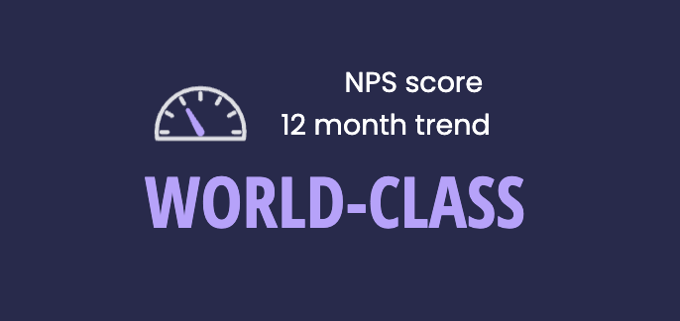We're not much for bragging. So we hope you'll forgive us, just this once. Because we're pretty proud of our NPS. Not just because we like high numbers, but because of what it says about our relationship with customers.
If you don't know, NPS stands for Net Promoter Score. It uses survey results to measure what percentage of your customers would recommend your business (promoters) vs. how many would warn people against it (detractors). The "net" is promoters minus detractors. It can range from -100 up to 100. An NPS of 0 would mean you have as many promoters as detractors. NPS has been pretty much the gold standard customer loyalty metric since it was introduced in 2003.
So what's a good NPS? The industry average for B2B software and SaaS companies is 40. For general technology & services providers, it's 61. And for consulting firms, it's 68.
WNDYR's 12-month rolling average NPS as of June, 2024 is... drum roll please... 82.
So whichever of those three industries you put WNDYR in - and we're a little bit of each - our NPS comfortably beats the industry average.

Customers cannot thrive on tech alone
Now, an NPS like that doesn't just happen because you build great tech. There's been lots of marvelous, elegant, sophisticated technology that flopped with the public. The business graveyard is littered with the remains of some amazing feats of engineering.
We earn that NPS by focusing on serving customers. By listening to them. By paying close attention to what they need, and keeping those needs at the heart of the solutions we design.
It seems like a simple idea. But it hasn't always been simple to put into practice. It's meant making some pivots when our best-laid plans didn't line up with what customers were actually looking for.
Don't get us wrong. Building great tech is essential. But if it doesn't solve a real customer problem, great tech isn't enough.
But wait, is NPS all it's cracked up to be?
Just a minute, you might be thinking. Aren't the ultimate measurements of customer loyalty things like revenue, profitability, and long-term customer value? You can't pay your bills with positive sentiment, right?
Indeed, that's one of the knocks against NPS. Polling a group of current customers, somewhat self-selected by their willingness to answer a survey, doesn't necessarily reflect a product's appeal in the marketplace.
A related concern is that a positive NPS can keep an organization from really searching for ways to improve their products - even if their financial performance is disappointing. "Our customers love it. We just need to raise awareness."
There's some truth in those criticisms. No metric is perfect. An excessive fixation on any one number in isolation isn't healthy for any business. But the positive relationship between NPS and revenue is also a fact.
NPS pays: happy customers mean a happy business
One of the first studies of NPS, by researchers at the London School of Economics, found that a 7-point increase in NPS correlated to a 1% increase in sales growth. Even more powerfully, just a 2% reduction in detractors correlated to another 0.83% in growth.
Companies with a positive NPS and low detractor scores (25% or less) grew four times as fast as those with negative net promoter scores and high detractor levels.
More recent studies have confirmed those conclusions. A 2018 paper by Staffordshire University researchers focused on the effects of NPS on one firm, the UK-based furniture retail chain DFS. It found that a sustained 1% increase in NPS would boost revenue by 0.5%, or £3 million per year. "In other words, more profit is generated by a one pp increase in NPS than by opening a new store," the report concluded.
And 2022 research by CustomerGauge found that a 10-point NPS increase strongly correlated with a 3.2% increase in up-sales revenue. Add it all up, and it's pretty clear: boosting your percentage of promoters and lowering your percentage of detractors can pump up your bottom line.
Great customer experience is the best investment you'll ever make
Here at WNDYR, we've seen the same effects over the past year. We saw dramatic increases in NPS in 2023, directly followed by strong improvements in customer growth and relationship value.
Is this about our tech expertise? Of course, in part. We're proud of the solutions our engineers build, and we'll put our tech muscle up against anyone's.
But we think our NPS edge comes from our unique emphasis on user enablement. That's one thing that has never changed since WNDYR's earliest days: investing in, and being purposeful about, delivering an exceptional customer experience.
That starts with really getting to know our customer organizations, their processes, their priorities, their people. And it continues through the tech implementation phase to change management. It's never been only about delivering a solution.
If we have one lesson for professional services providers, that's it: there's no substitute for investing time and resources in customer experience. We think our performance in 2023 is a vindication of what WNDYR has been doing all along.
Whatever its limitations, focusing on NPS helps keep us focused on our customers.
But hey, don't take our word for it. If your organization could benefit from taming the tangle of tools, platforms, and apps... if you need a digital transformation partner who truly understands what being a partner means... if you're ready to put technology in the service of your people and not the other way around, reach out to WNDYR today and see for yourself how we earned that 82.